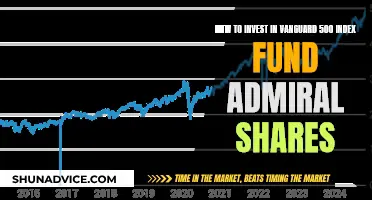
Investing in mutual funds is a great way to build a diversified portfolio without the extra cost or hassle. They are investment vehicles that allow groups of investors to combine their financial resources to purchase large portfolios of stocks, bonds, and other securities.
1. Set an investment goal: Identify what you're investing for and how long you plan to invest.
2. Pick a mutual fund strategy: Choose between active and passive funds. Active funds aim to beat the market, while passive funds try to mimic it.
3. Research mutual fund companies and funds: Look into the different companies that offer mutual funds, such as Vanguard or Fidelity, and research their menu of fund options.
4. Open an investment account: You can open a standard brokerage account through an investment company or bank, or take advantage of an employer-sponsored retirement account like a 401(k).
5. Decide on the mix of stocks and bonds: Determine your asset mix based on your goals, investment horizon, and risk tolerance.
6. Buy mutual fund shares: Some mutual funds require an investment minimum, which can range from $500 to $3,000. You can buy mutual fund shares directly from the fund company or through an online brokerage.
7. Manage your mutual fund portfolio: Consider rebalancing your portfolio annually to keep it in line with your diversification plan.
| Characteristics | Values |
|---|---|
| Investment goals | Long-term goals, mid-term goals, near-term goals |
| Investment strategy | Active funds, passive funds, growth funds, income funds, balanced funds, target-date funds |
| Investment account | Standard brokerage account, 401(k), IRA, Roth IRA, taxable brokerage account, education savings account |
| Asset mix | Stocks, bonds, commodities, cash equivalents |
| Investment research | Fund screeners, past performance, expense ratios, load fees, management |
| Investment amount | Minimum investment, lump sum, SIP |
| Investment timing | Daily, weekly, monthly |
What You'll Learn

Understand the different types of mutual funds
Mutual funds are broadly categorised into three types: equity, debt, and hybrid. Each type carries a unique risk-return profile, and your financial advisor can guide you in selecting the right fit.
Equity Mutual Funds
These funds invest in equity and equity-related securities with a primary objective of capital appreciation. Categories include large cap, mid cap, small cap, large and mid cap, multi cap, and thematic or sector-based funds.
Debt Mutual Funds
Debt mutual funds invest in debt and money market instruments, focusing on generating income. Categories are based on maturity or duration, such as overnight, liquid, ultra-short duration, low duration, money market, short duration, medium duration, medium to long duration, and long duration.
Hybrid Mutual Funds
Hybrid funds diversify across multiple asset classes like equity, fixed income, gold, or real estate investment trusts. Aimed at capital appreciation and income, they provide the advantage of asset allocation, spreading investment risk. Types include Aggressive Hybrid, Dynamic Asset Allocation or Balanced Advantage, Equity Savings, Multi-Asset Allocation, Conservative Hybrid, and Arbitrage funds.
Gold Fund Investment: A Smart and Secure Financial Move
You may want to see also

Set clear investment goals
Setting clear investment goals is the first step in investing in mutual funds. Before investing in any fund, you must identify your goals for the investment. Ask yourself: Are you investing for the short-term or the long-term? Is your objective long-term capital gains, or is current income more important? Will the money be used to pay for college expenses, or to fund a retirement that's decades away?
Your investment goals will depend on your age, income and outlook. For example, if you're in your 20s, you should have a very stock-heavy, if not 100% stock, allocation. If you're approaching retirement age, you'll want to have a substantial amount of stock exposure, but also a lot more bonds.
It's also important to be realistic about your goals. If your investment goals are unrealistic, outlandish or don’t match your current or expected earnings power, you may need to start over.
- Make each goal clear and specific
- Frame each goal so that you know when you have achieved it
- Take practical action to achieve your goals
- Determine whether your goals are relevant to your life and are realistic
- Assign a timeframe to each goal so you can track progress
Large-Cap Funds: When to Invest for Maximum Returns
You may want to see also

Choose a brokerage account
There are several options for brokerage accounts, each with its own advantages and disadvantages. Here are some of the most common types of brokerage accounts:
- Standard Brokerage Account: These accounts can be easily opened through an investment company or bank and offer a wide range of investment options, including stocks, bonds, and mutual funds. They are a good choice for those who want a diverse range of investment options.
- Retirement Accounts: If your employer offers a retirement account, such as a 401(k), you may already be invested in mutual funds. These accounts are tax-advantaged and are a common part of employer benefits packages. Contributions are often automatically deducted from your paycheck, and mutual funds are the most common investment option.
- Traditional Individual Retirement Account (IRA): If your employer doesn't offer a retirement plan, you can open a traditional IRA at most investment companies. IRAs offer a wide array of investment options and are funded with pre-tax dollars, allowing you to reduce your taxable income.
- Roth IRA: Roth IRAs are another popular option for retirement savings. They are funded with after-tax dollars, which means your contributions grow tax-free, and you won't owe taxes when you withdraw in the future.
- Online Brokerage Account: Most investors opt to buy mutual funds through an online brokerage. These platforms typically offer a broad selection of funds from different fund companies. When choosing an online brokerage, consider factors such as affordability, fund choices, research and educational tools, and ease of use.
When selecting a brokerage account, it is important to compare the fees and expenses associated with each option. Mutual fund investors may face transaction fees from the brokerage account and expense ratios or sales loads from the funds themselves. It is also essential to consider your investment goals, risk tolerance, and the level of service and support you require.
Strategies for Investing in Private Income Funds
You may want to see also

Research fees and fund performance
Fees are an important consideration when investing in mutual funds, as they will significantly affect your investment returns over time. Here are some common fees associated with mutual funds:
Expense Ratio
The expense ratio is an annual fee that covers the fund's operating expenses, including management fees, administrative costs, and marketing expenses. It is expressed as a percentage of the fund's average net assets and is deducted from the fund's returns. Over the last 30 years, competition from index investing and exchange-traded funds (ETFs) has led to a significant decrease in expense ratios. While in 1996, equity mutual fund investors incurred expense ratios of 1.04% ($1.04 for every $100 in assets), by 2022, that average had fallen to 0.44%.
Sales Charges or Loads
Some mutual funds charge sales fees, known as "loads", when you buy or sell shares. Front-end loads are charged when you purchase shares, while back-end loads are assessed if you sell your shares before a certain date. No-load mutual funds, which don't have commission or sales charges, are also available.
Redemption Fees
Some mutual funds charge a redemption fee when you sell your shares within a short period (usually 30 to 180 days) after purchasing them. This fee, limited to 2% by the U.S. Securities and Exchange Commission (SEC), is designed to discourage short-term trading in these funds for stability.
Other Account Fees
Some funds or brokerage firms may charge additional fees for maintaining your account or transactions, especially if your balance falls below a certain minimum.
When investing in mutual funds, it is important to carefully consider the fees and expenses involved, as they can significantly impact your overall investment returns. By comparing fees and expenses across different funds, you can make more informed investment decisions.
Invest Wisely: Franklin India Low Duration Fund Guide
You may want to see also

Decide on an investment strategy
When deciding on an investment strategy, it's important to consider your financial goals, risk tolerance, time horizon, and investment amount. Here are some key points to keep in mind:
- Long-Term vs. Short-Term Goals: If you're investing for the long term, such as retirement or your child's education, stock mutual funds offer potential for higher returns over time. For shorter-term goals, consider bond market mutual funds or high-yield savings accounts, which provide easier access to your money.
- Risk Tolerance: Evaluate your risk tolerance and decide how much risk you are comfortable taking. If investing heavily in stocks makes you nervous, consider balanced mutual funds that invest in both stocks and bonds to reduce potential rapid changes in investment value.
- Investment Horizon: Consider how long you plan to invest. If you have decades to reach your financial goals, a higher allocation of stock-based mutual funds may be suitable. For shorter-term goals, focus more on minimizing risk by investing in bond funds or other stable options.
- Investment Amount: Determine how much money you have available to invest. Mutual funds may have minimum investment requirements, so ensure you meet those thresholds.
- Diversification: Diversifying your portfolio across different asset classes and mutual funds can help manage risk. Consider investing in a mix of equity, debt, and hybrid mutual funds to spread your investments across various sectors and reduce the impact of market fluctuations.
- Costs and Fees: Mutual funds have various costs and fees, such as management fees, exit loads, broker commissions, and expense ratios. Carefully review the fees associated with the mutual funds you're considering to ensure they don't eat into your returns over time.
- Professional Advice: If you're unsure about your investment strategy, consider seeking advice from a financial advisor or mutual fund specialist. They can guide you in choosing funds that align with your goals and risk tolerance.
Smart Strategies for Investing Your Child's College Fund
You may want to see also
Frequently asked questions
There are several types of mutual funds, including stock, money market, bond, and target-date funds. Stock funds invest in equity, while bond funds focus on fixed-income securities. Money market funds are considered safe and low-risk, while target-date funds are tailored for retirement savings.
Mutual funds offer diversification, professional management, and a wide range of investment options. They are also highly liquid, making it easy to buy and sell shares. Additionally, mutual funds provide access to a diversified, professionally managed portfolio with a relatively low minimum investment.
When choosing a mutual fund, consider your investment goals, risk tolerance, and time horizon. Research the fund's performance, fees, and investment strategy. Compare different funds within the same category and select one that aligns with your objectives and risk profile. Diversify your portfolio by investing in multiple mutual funds to reduce risk.







